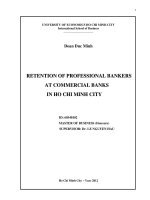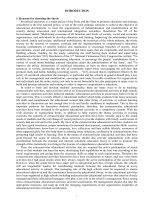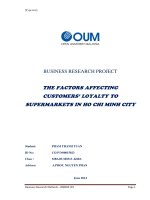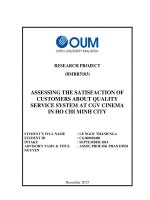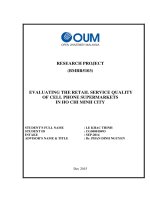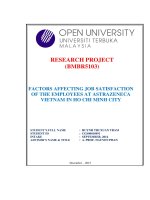The ineffective operating procedure at MORE UK in ho chi minh city
Bạn đang xem bản rút gọn của tài liệu. Xem và tải ngay bản đầy đủ của tài liệu tại đây (1.83 MB, 67 trang )
UNIVERSITY OF ECONOMICS HO CHI MINH CITY
International School of Business
------------------------------
NGUYEN THI ANH THU
THE INEFFECTIVE
OPERATING PROCEDURE
AT MORE UK IN HO CHI MINH CITY
MASTER OF BUSINESS ADMINISTRATION
Ho Chi Minh City – Year 2018
UNIVERSITY OF ECONOMICS HO CHI MINH CITY
International School of Business
------------------------------
NGUYEN THI ANH THU
THE INEFFECTIVE
OPERATING PROCEDURE
AT MORE UK IN HO CHI MINH CITY
MASTER OF BUSINESS ADMINISTRATION
SUPERVISOR: Dr. Phan Thi Minh Thu
Ho Chi Minh City – Year 2018
SUPERVISOR’S REPORT ON THE FINAL THESIS SUBMITTED
FOR THE DEGREE OF MASTER of BUSINESS ADMINISTRATION
Final thesis title: The Ineffective Operating Procedure at More UK in Ho Chi Minh
City.
Student name: Nguyễn Thị Anh Thư
Supervisor name: Dr. Phan Thị Minh Thư
1. General comments:
∙ Remarks on the student’s attitude:
.......................................................................................................................................
.......................................................................................................................................
∙ Remarks on the assignment’s academic quality:
.......................................................................................................................................
.......................................................................................................................................
2. Overall assessment:
□ Meet requirement for submitting;
□ Not meet requirement for submitting.
3. Other remarks:
- Did the student follow the report schedule?
□ Yes □ No □ Other.......................................................................
- The Turnitin plagiarism percentage:
❧✶❧
Supervisor’s signature
Table of Contents
Executive Summary ...................................................................................................................... 1
Introduction ................................................................................................................................... 3
CHAPTER I: INDUSTRIAL OVERVIEW AND COMPANY BACKGROUND ................. 4
1.1
Industrial Overview ...................................................................................................... 4
1.2
Company Background .................................................................................................. 6
CHAPTER II: PROBLEM JUSTIFICATION .......................................................................... 6
2.1
Problem finding process ............................................................................................... 6
2.2
Company’s Symptoms .................................................................................................. 7
2.3
Problem Identification .................................................................................................. 9
2.3.1
Problem mess ........................................................................................................... 9
2.3.2
Potential Problem.................................................................................................. 14
2.3.2.1
Ineffective partnership management ............................................................. 14
2.3.2.2
Ineffective operating procedure ..................................................................... 15
2.3.2.3
Unclear organizational structure ................................................................... 16
2.3.3
Identify the central potential problem ................................................................ 19
2.3.3.1
Central problem definition ............................................................................. 19
2.3.3.3
Justify the importance of central problem ..................................................... 21
2.3.3.3.1
Potential Consequences ............................................................................. 21
2.3.3.3.2
The problem importance in MORE UK .................................................... 22
CHAPTER III: ALTERNATIVE SOLUTIONS ..................................................................... 23
3.1
Cause validation .......................................................................................................... 23
3.1.1
Affiliative leadership style ...................................................................................... 23
3.1.2
Lacking of job description ..................................................................................... 24
3.1.3
Lacking of training ................................................................................................ 25
3.1.4
Poor planning and scheduling .............................................................................. 26
3.1.5
Language and Culture Barriers ............................................................................ 26
3.2
Proposed solutions ...................................................................................................... 27
3.2.1
Solution 1: Writing job descriptions ...................................................................... 29
3.2.2
Solution 2: Creating an official integrated process planning and scheduling .... 29
3.2.3
Solution 3: On-the-Job Training........................................................................... 33
3.2.4
Solution 4: Diversity training ................................................................................ 34
3.3
Alternative sets of solutions........................................................................................ 34
3.4
Action plan................................................................................................................... 37
3.4.1
Objective ................................................................................................................. 37
3.4.2
Timeline and Cost .................................................................................................. 37
Conclusion ................................................................................................................................... 44
Reference ..................................................................................................................................... 45
Appendix ...................................................................................................................................... 47
Appendix 1: The survey questions were contributed for choosing sets of solution .......... 47
Appendix 2: Interview ............................................................................................................ 48
Appendix 3: Related template which using in MORE UK operating procedure ............. 56
LIST OF FIGURE
Figure 1: Value chain of Vietnam’s textile and apparel industry……………………………5
Figure 2: Initial Cause – Effect Map…………………………………………………………..13
Figure 3: Updated Cause – Effect Map……………………………………………………….18
Figure 4: Solution Map…………………………………………………………………………..28
Figure 5: Sets of solution ……………………………………………………………………….35
Figure 6: The process of fabric development and importing process …………………….40
Figure 7: The process of developing neck ring trims and importing trim ………………..40
Figure 8: The actual hangover date and the docket hangover date……………………….41
LIST OF TABLE
Table 1: The amount of orders which transferred to supplementary factory………………7
Table 2: The CMT Price in VC factory and supplementary factory………………………...8
Table 3: The transferring expense to supplementary factories………………………...........9
Table 4: Proposed solution assigns the tasks for employee in Solution 2.1……………... 31
Table 5: Proposed solution assigns the tasks for employee in Solution 2.2……………... 32
Table 6: Survey result ……………………………………………………………………………36
Table 7: Timeline and estimated cost for Solution 1 ………………………………………..38
Table 8: Timeline for a bulk fabric ……………………………………………………………39
Table 9: Timeline for a bulk trim ………………………………………………………………40
Table 10: Timeline and estimated cost for Solution 3……………………………………… 42
DEFINITION OF TERMS
1. Merchandiser is a person who is the bridge between the industry and the buyer.
Merchandiser have to look after every job like buying the raw material which is
required to finish the product, making the garment, finishing the garment,
documentation, finally shipping.
2. Pattern maker is a person who take responsible for taking fashion designers
ideas and creating a workable pattern that will ultimately become an article of
clothing
3. Trims: The raw materials used in sewing room other than fabric, which materials
are directly attached to the fabric to make a garment are called trims. For example:
Threads, buttons, lining, Interlining, zippers, labels, etc.
4. Docket is the production orders to the factory. The docket is the order to your
factory that tells them exactly: What style to make, how many garments and the
size breakdown. What the hangover date is.
5. PP sample (Pre-production sample) is essentially an example of what will be
produced during the manufacturing process. The PP samples are garments that are
produced in the facility that is planning to manufacture the bulk order.
6. Lead time is the latency between the initiation and execution of a process. For
example, the lead time between the placement of an order and delivery of bulk of
button from a manufacturer may be from 10 days to 15 days
7. Hangover date is the delivery date of garment.
Executive Summary
The purpose of this paper is to point out the problem that exists in the operation of
MORE UK in Ho Chi Minh City and the author have proposed alternative solutions to
solve problems that help to manage the company become more effective
In Chapter I, the author introduces MORE UK as well as the general situation of the
garment industry in Vietnam. According to the company size, MORE UK is a rep office
which specializing in processing women's clothing and export to countries such as
England, Australia, America, Korea, .. as well as describe company products and
company structure
In Chapter II, the author analyzes the problem that MORE UK is facing. From problem
finding mess, the author presents the symptoms of the company that is MORE UK
looking for supplementary factories with better production capacity and clearer
production plans to take over orders because the main factory can not continue to handle
orders because of many problems between related parties such as: Customers changing
order detail information, low capacity of factory for production, Insufficient dealing FOB
price between MORE UK and factory, Lacking of person who charge in controlling
sample room and Lacking of merchandiser's role clarity internally MORE UK.
Therefore, MORE UK noticed that with the VC production capacity will not complete
the progress to export garments in time, hence, the Chief Rep make decision to find
supplementary factories which leads to pay higher CMT price and other costs as
transferring cost and importing cost
By the interview method, the authors proposed some potential problems leads to the
company symptom are Ineffective partnership management, Ineffective operating
procedure and unclear organizational structure, the central problem is ineffective
operating procedure. However, to justify the existence of problem, the author analyzed
the main problem in ineffective operation management, which led to issues related to
Ineffective partnership management, Ineffective operating procedure and unclear
organizational structure. These problems are linked together, however, the central
problem leading to the symptom is ineffective operating procedure officially.
The authors also show the importance of central problems by pointing out the potential
consequences which are increasing cost management, affecting firm performance and
1
customer satisfaction, which is unavoidable if the situation is not resolved. At the same
time, the author had pointed the level of important of these potential consequences when
this problem occurs at MORE UK to justify the importance of this central problem.
In Chapter III, the author is continuing to analysis the cause validation to find out what
causes of core problem of MORE UK is the presence of unexpected supplementary
factories. By interview and related theories, the author identified the potential causes of
the problem are Affiliative leadership style, Lacking of job description, Lacking of
training, Poor planning and scheduling and Language and Culture Barriers. Because the
cause “Affiliative leadership style” is an objective cause, the author did not build a
solution for this cause but focused on solving the remaining causes. By doing survey and
analysis, the author choose the set of solution is the combination of Writing job
description, Each employee in the merchandiser team will take responsible to follow up
one or two customer in whole process, from receiving purchasing orders to exporting the
goods and On- the- job training to develop action plan to solve problem of MORE UK is
ineffective operating procedure
The above is a executive summary of the thesis to give the reader a preliminary view of
the content of the paper. There is the full thesis "The ineffective operating procedure at
MORE UK in HO CHI MINH CITY" from the author.
2
Introduction
In recent years, in the tendency of world integration, Vietnam has succeeded and
developed the products in the country and has exported many kinds of goods such as
petrolium, textiles and garments, agricultural products, footwear, software, etc. to the
world and brings great value for this country. One of the main exporting goods is
garments.
MORE UK is a garment manufacturing company headquartered in Leeds, UK with the
main line of clothing for women, which is the intermediary company between the
factory, supplier and customer. The main purpose of this thesis is to explore the causes of
appearance of unexpected supplementary factories at MORE UK since the beginning of
2017. It leads to the increasing of related expenses, for instance, CMT price, transferring
expenses or garment quality. The methodology is the combination between validated data
and theories which collected through in-depth interview and company survey to explore
the causes of problem. The finding of the study revealed that ineffective operating
procedure is the main problem why it occuring the unexpected supplementary factories
and leads to the thing is that MORE UK have to pay higher CMT price for factory. From
the analysis, the author point out the central problem is the ineffective operating
procedure in MORE UK from receiving purchasing order from customer to ship the
garment back to customer is not effective. The causes led to it happens are from are
Affiliative leadership style, Lacking of job description, Lacking of training, Poor
planning and scheduling, Language and Culture Barriers. To solve the problems, the
author proposed the set of solution Writing job description, Each employee in the
merchandiser team will take responsible to follow up one or two customer in whole
process, from receiving purchasing orders to exporting the goods and On- the- job
training to help MORE UK can decrease the expenses which happens if the situation
continues.
3
CHAPTER I: INDUSTRIAL OVERVIEW AND COMPANY BACKGROUND
1.1 Industrial Overview
The garment industry is a craft industry in Vietnam and it has a long history. The
garment industry has experienced with rapid growth over the past years. This industry is
supplying clothes for the society, creating jobs for a large resource, and bringing a large
source of foreign currency from exporting and contributing a source of revenue to the
state budget.
Following the report of Textile and Garment industry, this industry is one of Vietnam's
key exporting sectors over the years. The total export of garment industry has always
been the leading exporters of Vietnam, behind petrolium. In 2013, Vietnamese garment
textile products are exported to more than 180 countries and territories with exporting
turnover of USD 17.9 billion, taking 10.5% of GDP in the whole country.
According to VITAS statistics in 2014, the percentage of exporting garment by CMT is
still around 85%, FOB is only 13% and only 2% is exported by ODM.
-
CMT (Cut- Make - Trim). This is the simplest method of textile export and
bringing the lowest added value. By cooperating in this method, the buyer
provides the whole of the input to the production company including trims,
transportation, design and specific requirements; Manufacturers only make
cutting, sewing and finishing products. The company have exported by CMT only
need to be able to produce and have a basic understanding of the design to
implement product samples. Finished products will be collected and distributed by
buyers.
-
OEM/FOB (Original Equipment Manufacturing/ Free on Board). This is “buying
raw materials, selling products”. For FOB orders, companies are responsible for
importing raw materials and producing orders. When producing this method,
company will actively add input materials to produce products. Accordingly, there
are two forms of FOB: FOB level 1 - purchasing of materials from the supplier
specified by the customer and FOB level 2 - the company takes responsible for
finding materials
-
ODM (Original Design Manufacturing) This method is including the designing
stage and the production process from purchasing fabric, trims, cutting, sewing,
4
finishing, packing and transportation. Design capabilities represented a higher
level of knowledge of the vendor, thus, it brings a much higher added value to the
product. ODM businesses create designs, complete products and sell them to
buyers/customers who often the owners of major brands around the world.
Due to its strong potential production with abundant labor resources, low labor cost and
it is prioritized to develope by government, Vietnam garment industry has attracted a
large amount of foreign investment and facilitating production, contributing to improving
product value. According to statistics by the General Department of Customs, in the first
11 months of 2017, Vietnam garment industry exports reached $28.84 billion, an
increase of 11% over the same period of 2016. This is a relatively high growth rate
compared to 5.2% growth in the same period of 2016. In 2017, foreign investment in
garment increased by 10% mainly from US, EU, Japan, Korea. China, Russia, Hong
Kong, Thailand,... This contributes significantly to balance the trade balance of the
economy. In fact, in recent years, the tendency of shifting production orders from China
to Vietnam because low labor price is more competitive than China.
According to Vietnam Textile and Apparel Association (VITAS), the main components
of its value chain include tight connection among raw material suppliers, domestic
manufacturers, intermediaries and international customers, as shown in Figure below
Figure 1: Value chain of Vietnam’s textile and apparel industry.
5
1.2 Company Background
MORE UK LTD is an intermediary company that has been operating in the fashion
business for over 15 years and has built a solid foundation for delivering quality,
ethically produced, design lead products. With decade of experience built into the team,
MORE UK are able to offer a diverse and commercial range of ladies wear products
using high quality, trend lead fabrics and trims. MORE UK’s global network of offices in
Leeds, London, Vietnam and China allows us to offer exceptional customer service with
competitive price. MORE UK Representative Office was established in Ho Chi Minh
City in 2014. Currently, to 2018, there are 15 employees in this office, excluding 5 QCs
(Quality Controls) who has worked in sub-contract factories. MORE UK garments are
usually blouse, trouser, jacket, coat, dress, woman clothes, in which the proportion of
blouse orders is high in the company. MORE UK usually looking for customers who
want to place the blouse orders because it is the strength of MORE UK. In the main
export markets of MORE UK are usually the UK, Australia, South Korea, USA,... In
which, the UK market accounted for the highest proportion. The function of the
representative office is only to carry out trade promotion activities and market research.
In the range of this paper, we only analysis the situation in Representative Office in Ho
Chi Minh City, Viet Nam
CHAPTER II: PROBLEM JUSTIFICATION
2.1 Problem finding process
Being a representative office, the main activity of the office is to carry out market
research and promote trading activities in the textile and garment industry in Vietnam.
With a source of customers which are cooperated directly by parent company in the UK,
MORE UK Rep Office will search for factories, suppliers to carry out garment
processing operations in Vietnam then export garment under the outsourcing factory’s
name
At present, VC is one of the main outsourcing factory which product MORE UK orders
of blouse and trousers. With a close and cooperative relationship for many years, VC
usually offer reasonable CMT price and quality of products are accepted by customers.
By observing all aspects of the company, the author finds that the appearance of another
factory (HUY HUNG, CONG PHAT, PHU KHANG) to replace the main factory (VC)
6
orders to catch up the hangover date which takes proportion is 35% -55%. The author
checked the order numbers from quarter I/2017 to quarter II/2018 and interviewed related
staffs who are merchandiser, planning employee and the pattern makerworks with the
factory to find out the cause of the problem. The first symptom is the increasing costs
including CMT prices, the cost of transporting the materials to the supplementary
factory.
2.2 Company’s Symptoms
According to finding unexpected supplementary factories, it leads to increase some
expenses, especially CMT price. The VC factory's failure meets the hangover date lead to
find an unexpected supplementary factory. The consequence when occurs the replace
factories are the increasing of CMT prices and other costs that have affected the
profitability of orders since the beginning of 2017.These tables below show the detail
symptom.
Q1/2017
Q2/2017
Q3/2017
Q4/2017
Q1/2018
Q2/2018
The total of order
115
90
140
120
108
95
The amount of order in
17
15
15
13
11
11
6
3
5
6
6
4
35%
20%
33%
46%
55%
36%
main factory (VC)
The amount of order which
transferred to
supplementary factory
Percentage (%)
Table 1: The amount of orders which transferred to supplementary factory
In table 1, it shows the amount of orders which transferred to supplementary factory
(PHU KHANG, HUY HUNG, CONG PHAT). Because VC factory can not produce the
good of garments meet the hangover date, MORE (UK) have to transfer all raw materials
to replaced factory. Based on the data in Table 1, the percentage of orders to be shipped
7
to other processing supplementary is significant, especially in the IV/2017 and I/2018. As
this is the peak season of the apparel industry, the volume of garment exported to
countries in the UK and Australia is big, therefore the orders are full capacity in VC. Due
to many objective and subjective causes that will be explain in Situation analysis, many
orders can not put inline for production in VC factory that leads to MORE UK looking
for supplementary factories with better production capacity and clearer production plans
to take over orders.
Finding supplementary factory increases costs such as the CMT price at the new factory
will be higher than the CMT price at the VC. Generating operating expenses such as the
cost of transporting the fabric from the VC factory to the new factory, the cost of
importing and export goods at the new factory. At the same time, the cost of PP preproduction samples increases as each factory needs to sew PP samples to know how to
produce samples in bulk.
In the limit of this article, the author only mention to the average CMT Price for each
blouse and trouser with MILLERS customer for instance
Blouses
Trousers
CMT Price in VC factory
$1.5
$2.2
CMT Price in supplementary factory
$1.7
$2.5
Table 2: The CMT Price in VC factory and supplementary factory
The cost of transporting goods by truck to the replacement plant depends on the distance
between the plants and the number of fabrics and materials, if the bulk order, the
maneuvering 2-3 trucks for transportation high cost. According to data from the
accounting department, the average costs incurred are listed in the table below
8
The amount of order which
Q1/2017
Q2/2017
Q3/2017 Q4/2017 Q1/2018 Q2/2018
6
3
5
6
6
4
$2,100
$1,050
$1,700
$2,300
$2,400
$1,400
transferred to supplementary
factory (HUY HUNG, CONG
PHAT)
Transferring expenses
Table 3: The transferring expense to supplementary factories
In addition, the cost of making PP samples is doubling, depending on the requirements of
customers, such as customer MILLERS, PP samples will be 3 pieces, a size 10 and 2 size
14. When VC factory receives orders from MORE UK, after receiving the bulk fabric for
the production, the factory will sew 3 PP samples to know how to process the garment
and apply for production. Depending on the type of blouse or trouser, the cost of these
styles will increase with its complexity.
2.3 Problem Identification
2.3.1 Problem mess
After the symptom analysis, the increasing of CMT price and management expenses are
the result of “unexpected supplementary factories” company symptom. To have a deep
understanding and find the potential problems, the author have conducted the interview
with Ms. Kim Dung - Merchandiser who working directly with the VC factory and have
new findings. To sum up, there are many causes for the symptom “unexpected
supplementary factory” in MORE UK situation
-
Time consuming for sample approval: According to Ms. Dung, "It is very timeconsuming to wait for approval from customers for fabric and trims which making
by suppliers, which leads to MORE UK merchandisers sometimes fail to order
controlling and late delivery to the factory ". In this industry, every single details
which are main fabric, buttons, zippers, eyelets, lining, labels,...which are
approved by customers. After receiving the purchasing order and the technical
packs from customers, MORE UK has to find suitable suppliers in terms of price
9
and product quality that require the suppliers to provide trim samples. The
supplier will take of few days to send sample to MORE UK then will send to
customers to get approval. Because almost of MORE UK customers are
Australian and UK branches, hence the delivery time by DHL, FEDEX or UPS
will take a few days. In addition, because of difference time zone and MILLERS
customer is only give response in every Tuesday and Thursday, it takes long time,
sometimes we lost a whole week to get approval for a button. Then, if the
customer approves, the bulk will be imported to the factory in Vietnam.
-
Changing order detail information: This problem rarely happens but MILLERS
customer sometimes make some changes to the product, for example, changing
information in the price ticket label while MORE UK had placed the all label
orders and put it in finished garment. So when customers change information it
will take time and money to MORE (UK) order and produce the price tag from the
beginning. This is also one of the factors that affect to the time of production
orders and leads to main factory can not have enough ability to finish it and need
the support from supplementary factory.
-
Low capacity of factory for production: After the contract is executed with CMT
price for each order or multiple orders at the same time, MORE UK will cooperate
to main suppliers and import fabrics, trims from China or in local and transfer to
VC factory to start production. Under the contract, VC have committed to ship
garments to the customer on the hangover date. However, in reality, "VC did not
conduct cutting, sewing activities at the factory until the hangover date, the fabric
was not spread out to make the fabric cutting, which led to the factory have not
had garments to ship out. They received so many orders at the same time but
limited capacity, therefore they can not control all orders that have the same
hangover date”
-
Insufficient dealing FOB price: Because MORE UK customers are in the
medium and low cost segment, the company always co-operate to factories who
offer the lowest CMT price with the right quality, including VC factory. From
beginning 2017 to now, almost orders of MORE UK have been signed processing
contract with VC factory, especially the blouse and trouser orders. According to
10
Ms Dung "For MILLERS customer, for instance, their orders are blouse and
trouser almostly, their FOB offers to us is very cheap, therefore, we place orders
at the VC factory because the CMT is cheap as well with the designs and
customer requirements, which is a prerequisite to choose factory"
-
Insuffcient ordering fabric and trims process: Because the lead time of fabric
and trims are not the same, it’s hard for merchandisers control when it should
import materials. For example, the lead time of fabric is 60-70 days, trims such as
buttons, zipper, lining,... takes about 10-15 days for production which then sent to
customers for inspection and approval for production”. The period of time for all
trims and fabric to be delivered to the factory takes a months, this is also one of
the causes that the factory can not produce the hangover date. In addition,
sometimes, the quality of the trims are not guaranteed or the supplier produces and
sends the defective product to affect the progress of the factory because of cutting
time, making and sewing is not synchronized with the time of the fabric and
materials imported, which caused the factory to be delayed in the production.
Merchandiser have to know the lead time of materials carefully, but they do not
really effective to control and make sure all materials have to be in factory at the
same time, which make sure the factory have all materials to start production
-
Lacking of person who in charge of controlling sample room: At present,
MORE UK has only technical controls on the samples.The requirement for
specific samples has not been controlled, which only under the control of
merchandiser leads to the sample room does not know which sample is the
priority. At the same time, the quality of samples was not checked closely, so
many samples were sewn several times to meet the customer’s standard. This time
consumes in the production process, the factory can not catch up the hangover
date in time.
-
Lacking of merchandiser’s role clarity: Merchandisers and planning staff have
similar job. There are many internal issues to be considered. Management system
and work assignment are not clear, merchandiser department has not really
worked effectively. The order receiving department and the planning department
do not have a clear working assignment that leads to across function and working
11
duplication. Sometimes, merchandisers and planning staff have a similar work, for
example, a merchandiser and a planning staff are working with one supplier for
the same order, same styles. Besides it, because of high workload with many
customers, merchandiser team always in high pressure of working. In addition, the
pressure to work with the VC factory also makes the merchandiser department
work really not effective
From the above, MORE UK noticed that with the VC production capacity will not
complete the progress to export garments in time, hence, the Chief Rep make decision to
find supplementary factory such as Phu Khang, Huy Hung, Cong Phat to replace VC.
The happened things are the price of CMT will be higher than VC, and other expenses
such as the cost of fabric and trims transporting from VC to the supplementary factory,
the cost of importing and exporting, the custom expenses, etc... This increases the
management cost MORE UK office in Vietnam in particular and affects to the profit of
MORE UK in general.
In average, an order takes a total of 3 – 3.5 months since MORE UK get the purchasing
order from the customer to the hangover date. Ideally, if there is no factory change,
MORE UK will guarantee delivery time and quality of goods with customer. If the VC
can’t complete the production planning, the things happen is transferring all fabric and
trims to another factory and the requirement for completion in a shorter time than the
average time, it will partly affect the quality of the product and increase the risk for
MORE UK if the supplementary factory can not keep up with the process, in case if the
order is difficult to take more long time to produce that orders
The whole picture will be demonstrated as Initial Cause - Effect Map below:
12
Time consuming for approval
samples
POTENTIAL
Changing order detail information
PROBLEMS
Low capacity of factory for
production
Ineffective
partnership
management
Insufficient ordering fabric and
trims process
Ineffective
internal
management
Taking longer production time
Insufficient dealing FOB price
Unexpected
supplementary
factories
Materials have not been at the
factory at the same time
Lacking of person who in charge of
controlling sample room
Higher CMT
Price
Lacking of merchandiser’s role
clarity
Ineffective merchandisers
Merchandiser and planning staff
have a similar job
Figure 2: Initial Cause – Effect Map
ORGANIZATION
SYMPTOM
13
From the problem finding process and the initial cause effect map, MORE UK have
many orders from MILLERS customer and focusing on finding the new supplementary
factories when VC can not response the MORE UK demand because of many objective
and subjective reasons. Therefore, the consequence is the increasing of CMT and some
expenses from the symptom at beginning is “unexpected supplementary factories. In next
session, the author will do related literature reviews that are as the theory framework
linking with the “unexpected supplementary factories” symptom of the company. Then
the author will find out the core problem using data collected from depth interviews with
the planning staff.
2.3.2 Potential Problem
By doing the depth interview with a planning staff, a merchandiser and a pattern maker
to discover what are the potential problems lead to the existing symptom of MORE UK.
The author has collected related information and had done some researchs to support the
interviewee’s points.
2.3.2.1
Ineffective partnership management
Making an interview by exploring questions with Ms. Georgina - planning staff who
works directly with MILLERS customers, she said, "The problem is that it is very
difficult to synchronize the way partner works: the factory - the supplier - the customer,
this is a closed circle process. Waiting for the approval of customers and the lead time of
goods of different fabric and trims are different totally, the synchronization and sending
the request to the factory is difficult to control. The question is how to manage all
partners and make it effectively. In addition, MORE UK have to integrate all activities
from sourcing raw materials (fabric and trims), sourcing factories for manufacturing and
making, sewing in factory, sourcing courier to import samples from oversea and other
management.
The pressure on the chief of the representative office and the merchandiser is looking for
cheap factories, cheap suppliers but still have to ensure the quality of stable goods to get
profit from the orders. The appendix 2 is the costing sheet of the WSTP13245M and the
FOB price quoted by the customer. This is the style which transferred from the VC
factory to the CONG PHAT factory with the CMT price is $ l.7, the main fabric price
14
and trims are only $ 1.46, the FOB price is $ 5.4, which not including other management
costs such as labor cost, miscellaneous expense, MORE UK does not seem to be getting
profit from these orders. To decrease the material expenses and the CMT price, MORE
UK has to find and negotiate to supplier and factory. Hence the problem is that looking
for the suitable partners that having average price and increase profits for the company.
In addition, the selection of a production factory with production capacity to ensure
compliance with the law and delivery on time with the CMT price must be reasonable.
Because MORE UK is small company and lack of the resources, it is facing the problems
of distance from Vietnam to customers in UK or Australia, long production lead time and
quality control that force MORE UK have to control the partnership effectively.
From all above, MORE UK have an unsuitable partner selection with company to
achieve the business target. According Zhou D, Peng Y, Chen YS1 “the contractor often
put too much focus on price, ignoring other important factors, leading to lost
opportunities of cooperating with better partners”. In MORE UK, it likely to occur that
the partner’s strategy and MORE UK’s strategy does not match about the price, quality
and production ability, so it happens the appearance of supplementary factory and it is
increase the overall costs, reduce the profits of company
Regarding of deadling FOB price with customer, because of low FOB, MORE UK have
to deal low CMT price with factory. This is the conflict of interest, because during the
cooperation, both sides just want to gain the best price, resulting in some conflicts of
goals and needs. In the long-term cooperation, the problem of asymmetric information
exists in the agency relationship, which will increase the total cost of both sides, affecting
its stability and competitiveness.
2.3.2.2
Ineffective operating procedure
Following Gough J2, operating procedures are binding for a company, and that a
procedure in place means the company must follow it.Operating procedures are written,
step-by-step instructions that describe how to perform a routine activity. Employees
should complete them in the exact same way every time so that the business can remain
consistent, in addition, with the effective operating procedure, it helps company save
time and money, holds the employees accountable because Without standard operating
15
procedures, employee evaluations become a matter of personal opinion, which is hardly
fair to your employees and reducing the risk of employee risk.
At MORE UK, when the author made the interview with Ms. Ngoc Lan who is a member
of merchandiser team, she said “Almost merchandisers are overloaded because of too
many orders from different customers but they have not really worked effectively
actually, it leads to high workload which causes employees to always be stressed and
tired. The process of placing fabrics and materials from receiving purchasing orders from
customers until the transfer of all fabrics and trims to the factory is still limited because
the lead time of fabrics and trims are different. The relevant positions such as
merchandiser, pattern maker, QA/QC actually do not work effectively, who have not
created an official process at the factory and ensure the quality of goods when shipped
garment to customers. At MORE UK, the process from receiving your order until the
shipment is really shortcoming, there is no official procedure for the employee to follow.
There is the lacking of planning and scheduling when merchandiser and planning staff
work to related parties. The procedure of placing fabrics and trims not synchronized,
sometimes, it can not be imported to factory at the same time that led to increasing
importing expenses and the factory can not put all materials in line in production because
of ineffective operating procedure.
2.3.2.3
Unclear organizational structure
Nahm et al3 defined “Organizational structure is normally described as the way
responsibility and power are allocated, and work procedures are carried out among
organizational member”. According to Rajan D4 “unclear and non-transparent
organization structure and policy, unfair work shift and unhealthy interpersonal
relationship such as conflict, dispute at workplace will cause stress which will further
affect their job performance.”
One of the main difficulties which MORE UK is facing is that the company's server
system is slow and always has problems accessing, which makes the work process of the
staff sometimes interrupted. According to Ms. Lan "Because the server system is located
in the UK, sometimes when the office of Vietnam has a problem, we have to spend a
whole day that waiting for IT in the UK to solve the problem because of time zone’s
difference. It’s necessary when merchandiser gets important information on the CMT
16
price on the system to do Costing sheet and send to factory, however, because the system
is faulty which causing the work to be delayed. Another problem here is that the
organizational structure is not clearly actually, there is not a clear job description in every
position. Merchandiser and the planning staff sometimes have similar functions because
of lacking of role clarity. In addition, MORE UK sample room sometimes makes the
wrong pattern with customer requests and takes time to revise and fix it. In addition,
there is no one who is in charge of following samples in sample room for ensuring the
quality of the sample as well.
There is the updated cause-effect map below:
17
Figure 3: Updated Cause – Effect Map
POTENTIAL
PROBLEMS
Ineffective
partnership
management
Time consuming for approval
samples
Changing order detail
Low capacity of factory for
production
Insufficient dealing FOB price
Ineffective
operating
procedure
Insufficient placing fabric and
trims process
Lacking of person who in
charge of controlling sample
room
Unclear
organizational
structure
Unexpected
supplementary
factories
Lack of merchandiser’s role
clarity
Higher CMT
Price
ORGANIZATION
SYMPTOM
Poor server system
18


